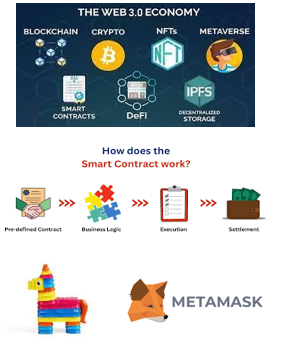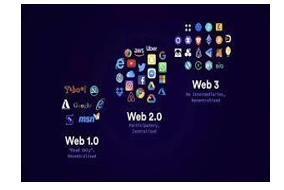Ijraset Journal For Research in Applied Science and Engineering Technology
- Home / Ijraset
- On This Page
- Abstract
- Introduction
- Conclusion
- References
- Copyright
Campus Connect - Bridging the Academic Community with Blockchain-Powered Decentralization
Authors: Shreya Tyagi, Shikhar Srivastava, Geetanjali Raj
DOI Link: https://doi.org/10.22214/ijraset.2024.60921
Certificate: View Certificate
Abstract
In response to the evolving landscape of education in the digital era, CampusConnect emerges as a transformative blockchain-based decentralized application. This platform seeks to redefine the college experience by establishing a secure and collaborative environment for students, faculty, and campus communities. Leveraging blockchain technology, CampusConnect ensures data integrity, transparency, and decentralization, addressing the limitations of traditional social media platforms in meeting the unique needs of educational institutions. The objectives of this innovative initiative include enhancing communication, promoting resource sharing, improving campus event management, and offering a specialized academic network.
Introduction
I. INTRODUCTION
In the contemporary landscape of digital connectivity, social networking systems have become ubiquitous, serving as essential platforms for interpersonal communication. However, existing public social networking systems often fall short in catering to the specific needs of users within the unique environment of a college campus. The integration of users' learning, working, and cultural life on campus with their real- world activities is a critical aspect that is often inadequately addressed. To bridge this gap, our project introduces Campus Connect, a groundbreaking blockchain-based decentralized application designed to revolutionize the college experience for students, faculty, and campus communities.
The conventional social networking systems, while meeting general communication needs, lack the depth required for the seamless integration of academic, cultural, and managerial aspects within a university setting. Campus Connect not only fulfills the fundamental communication function but also provides a unified platform for teaching, research, management, and cultural activities. This innovative system emerges as a robust support system for the information construction of universities, fostering an environment where users can actively engage with the diverse facets of campus life.
Amid the proliferation of social networking sites among college students, research efforts to discern the relationship between social media use and academic performance have been substantial but inconclusive. Existing studies often rely on self-reports, and findings lack consistency, overlooking potential moderating factors. Campus Connect steps into this academic landscape as a dedicated space where students communicate freely, access essential resources, and actively participate in their academic journeys.
Addressing the drawbacks and benefits of social media practices in higher education, Campus Connect leverages blockchain technology to provide a secure and transparent platform. The use of smart contracts enhances security, making it nearly impossible to compromise information. The platform caters exclusively to college students, offering functionalities akin to popular social networking platforms. By creating an account, users unlock features facilitating seamless communication and fostering engagement within the student body.
In an era where digital connectivity is paramount, Campus Connect stands as an innovative solution, creating a secure, transparent, and collaborative ecosystem for academic and social interactions within the college community. This platform redefines the college experience, bringing together students, faculty, and administrators in a shared space dedicated to enriching the academic and cultural aspects of campus life.
This paper delves into the technological underpinnings of CampusConnect, exploring the use of blockchain, smart contracts, IPFS and tokenization. It outlines the rationale behind the development of CampusConnect, emphasizing the unique challenges faced by educational institutions and the transformative potential of this decentralized application.
The objectives of CampusConnect are detailed, highlighting its role in enhancing communication, promoting resource sharing, improving campus event management, and providing a specialized academic network. This initiative represents a significant step towards reshaping the digital landscape of education, fostering a more connected, collaborative, and efficient academic community.
II. LITERATURE REVIEW
The literature surrounding decentralized applications (Dapps) and blockchain technology provides a rich tapestry of insights that contextualize and inform the development of CampusConnect, a decentralized application tailored for enhancing the college experience.
In the contemporary landscape of Online Social Networks (OSNs), scalability and privacy concerns have prompted a shift towards decentralized applications (Dapps). "D-Space" critically addresses the limitations of centralized OSNs and explores Dapp designs to achieve decentralized social networking. This aligns with our project's objectives by emphasizing the importance of decentralization in providing users with control over their data, ensuring privacy and security. [1].
Kushwaha, Singh, and Vats delve into the realm of blockchain applications, specifically focusing on social media platforms. This study provides a technical analysis of blockchain-based social media platforms, shedding light on characteristics crucial in a blockchain-based social media context. The use of Proof of Authentication and consensus protocols aligns with our exploration of blockchain technology on CampusConnect, contributing valuable insights from a business perspective.[2]
Chandrasekhar and Padmavati's paper explores decentralized image sharing applications, addressing concerns about user privacy, data integrity, and centralized authority. The introduction of a decentralized framework and the token-based incentive system for users aligns with our study on CampusConnect's utilization of blockchain technology, contributing to a broader understanding of decentralized applications in various contexts [3].
Gangavarapu's paper sheds light on the safety and security challenges posed by Extended Reality (XR), especially for teenagers. While our focus is on a different domain (academic environments), the concerns raised about the potential negative impacts of advanced immersive technologies resonate. The paper contributes to the broader discussion on the ethical use of technology, aligning with the need for secure and responsible implementations, as also envisioned in CampusConnect [4].
Zhang's paper explores the intersection of blockchain technology and Metaverse development. It emphasizes the role of smart contracts in facilitating economic development within virtual scenes through tokens. This work contributes to the understanding of blockchain's application in virtual environments, aligning with our study on CampusConnect's use of blockchain technology [5].
This research addresses the application of a blockchain consensus algorithm for large-scale high- concurrency power transactions. Although the focus is on the energy sector, the study contributes insights into consensus mechanisms crucial for business responsiveness and performance. This aligns with our broader exploration of blockchain applications, including CampusConnect [6].
Gonçalves et al.'s paper explores the integration of blockchain technology into the Internet of Things (IoT) landscape for data storage. By focusing on secure, decentralized solutions for data storage in IoT scenarios, the paper contributes to the growing understanding of blockchain's potential across various domains. The findings align with our study on CampusConnect's utilization of blockchain technology [7].
The paper proposes Committable, a decentralized and trustless protocol, aligning with broader trends in blockchain applications for collaboration in open- source development. This work contributes to the exploration of decentralized solutions, complementing our study on CampusConnect [8].
Gazsi et al.'s research introduces the VAULT protocol, emphasizing secure permissioned blockchain- based decentralized systems for data access and collaboration. This work contributes valuable insights into scalable, secure, and decentralized solutions for data access, aligning with our study on CampusConnect [9].
Christodoulou and Christodoulou's exploration of using blockchain to combat fake news resonates with our study. By introducing a decentralized application on the Ethereum blockchain, the paper addresses the challenges posed by misinformation, presenting a framework that allows readers to self-verify the trustworthiness of news sources. This aligns with our goal of leveraging blockchain to create a secure and transparent academic environment on CampusConnect [10].
In summary, the reviewed literature provides a comprehensive understanding of blockchain-based applications, offering valuable insights that inform the development of CampusConnect, contributing to the broader discourse on decentralized and secure solutions across various domains.
III. METHODOLOGY

A. Understanding Web3.0 Integration
Evaluate the compatibility of CampusConnect with Web3.0, ensuring seamless integration into the decentralized online ecosystem.
Implement protocols that allow direct user communication within decentralized autonomous organizations (DAOs) to enhance user interaction.
B. Leveraging IPFS for Secure Data Storage
Integrate IPFS for peer-to-peer, version-controlled file storage, ensuring secure and decentralized data management.
Utilize IPFS concepts, including distributed hash tables and merkledag, to facilitate efficient and reliable data sharing.Implementing Open Zeppelin (ERC-721) for NFT Standards
C. Incorporate Open Zeppelin's ERC-721 non- fungible token standard for the creation and management of non-fungible tokens within CampusConnect.
Enable features such as token transfers between accounts, tracking token balances, and identifying ownership for enhanced user engagement.
D. Smart Contract Development with Truffle
Employ Truffle for smart contract development, allowing efficient testing, compilation, and deployment of decentralized applications on the Ethereum network.
Leverage Truffle's capabilities for debugging and stack tracing to ensure the integrity and functionality of smart contracts.
E. Ensuring Data Integrity with Sanity.io
Integrate Sanity.io to ensure data integrity and facilitate seamless content management within CampusConnect.
Leverage Sanity.io's real-time collaborative features to enhance the overall user experience.
F. Pinata Integration for IPFS Pinning
Use Pinata as an IPFS pinning service to provide a quick, reliable, and easy way for users to share their work without limitations.
Implement Pinata to ensure the persistence and accessibility of content hosted on IPFS.
G. Enabling Decentralized User Authentication with Metamask
Integrate Metamask to enable decentralized user authentication and secure user interactions within CampusConnect.
Leverage Metamask's capabilities to manage user identities and private keys securely.
H. API Development for Seamless Integration
Develop APIs to facilitate seamless integration with external services and platforms. Ensure compatibility and smooth data exchange between CampusConnect and external systems through well-defined APIs.
I. Utilizing Alchemy for Blockchain Development
Integrate Alchemy as the primary blockchain developer platform for secure design, testing, and monitoring of decentralized applications.
Leverage Alchemy's reliable node management and network connectivity for efficient blockchain interactions.
J. User Interaction through Web3.0 Concepts
Implement Web3.0 concepts to enhance user interaction and engagement within the CampusConnect platform.
Utilize smart contracts and decentralized technologies to offer users greater control over their data and interactions.
By adopting this comprehensive methodology, CampusConnect aims to create a decentralized, secure, and user-centric platform,providing an innovative and reliable college experience for students, faculty, and campus communities.
IV. ALGORITHM

In the conventional social media model, user interaction occurs through a user interface, typically facilitated by an application or website. A web-API acts as the intermediary between the user system and the server, constituting a three-tier structure. User data is conventionally stored in data centers nationwide. The company retains the right to leverage this data for tailored services, as it is considered proprietary.
Whereas, In the proposed project envisions a decentralized Social Dapp enabling users to create accounts, manage tweets, and exchange messages. Leveraging networks like Rinkebey with ethers for transactions aligns with the decentralized nature of blockchain technology.
Deployment involves Ethereum IDE, IPFS, Truffle, Alchemy, Sanity IO, and Metamask. The foundation rests on the Ethereum Blockchain and its smart contract capabilities.
Streamlined User Journey on CampusConnect
- Get Started:
- Users download and install the MetaMask browser extension.
- Create a new Ethereum wallet within MetaMask.
2. Access the Platform:
- Log into the decentralized App using the MetaMask wallet.
- Verify the MetaMask wallet address for validity.
3. Engage and Create:
- Explore the Twitter feed, connect with the community.
- Create new tweets, securely stored on the Ethereum public blockchain.
4. Transparent Records:
- Leverage distributed ledger technology for secure and transparent user activity records.
5. Decentralization in Action:
- Ensure decentralization, preventing any single entity from monopolizing user data or interactions.
6. College Affiliation and Security Boost:
- Connect the college mail ID during sign-up,for enhanced security and college community affiliation.
7. NFT Profile Minting:
- Verified users mint a unique profile image as an NFT on the Ethereum Blockchain.
8. Secure Storage on IPFS:
- Store the minted NFT profile image securely on IPFS for tamper-resistant access.
9. Smart Contracts for Autonomy:
- Manage the minting process with smart contracts for transparency and user autonomy.
10. Enhanced Experience:
- Fortify the user experience with streamlined verification and personalized features, aligning with CampusConnect's decentralized ethos.
Conclusion
Our project offers several advantages to students, such as the ability to make new friends quickly and easily, stay updated on new ideas and perspectives, and share and obtain knowledge through the application. Students can also join groups based on their interests or topics, and highlight issues affecting them or their college community. Additionally, registered users can chat with each other, like and comment on posts shared by others they follow, while using of smart contracts and blockchain creates the secure environment so that user did not have to worry about there security concern so that they can use the site endlessly without any hesitation. 1) Our social networking platform allows students to easily make new friends and expand their social circle within a short period of time. 2) By staying connected through the platform, students can stay up-to-date with new thoughts and views, and benefit from exposure to a wide range of perspectives. 3) The platform provides an excellent opportunity for students to share and obtain knowledge on various topics, thereby facilitating learning and personal growth. 4) The platform enables users to like and comment on posts shared by other registered users they follow, thus fostering engagement and interaction among users. 5) The platform offers the convenience of user management, with the admin being able to manage users, view their profiles, and chat with them as needed.
References
[1] M. A. Devmane, \"D-Space: A Decentralized Social Media App,\" 2023 2nd International Conference on Edge Computing and Applications (ICECAA), Namakkal, India, 2023, pp. 809-814, doi: 10.1109/ICECAA58104.2023.10212341. [2] D. Kushwaha, K. Singh and S. Vats, \"Enhancing the Transaction Mechanism for Blockchain Application: A Business Perspective,\" 2023 5th International Conference on Inventive Research in Computing Applications (ICIRCA), Coimbatore, India, 2023, pp. 1214-1220, doi: 10.1109/ICIRCA57980.2023.10220727. [3] U. Chandrasekhar and E. G. Padmavati, \"Decentralized Image Sharing App using Blockchain,\" 2022 International Conference on Smart Generation Computing, Communication and Networking (SMART GENCON), Bangalore, India, 2022, pp. 1-5, doi: 10.1109/SMARTGENCON56628.2022.10083875. [4] A. Gangavarapu, \"Making Extended Reality Safe and Secure for Teenagers with ParGuard,\" 2022 ITU Kaleidoscope- Extended reality – How to boost quality of experience and interoperability, Accra, Ghana, 2022, pp. 1-3, doi: 10.23919/ITUK56368.2022.10003052. [5] X. Zhang, \"Blockchain Technology based Metaverse Development Application,\" 2023 IEEE 6th Information Technology,Networking,Electronic and Automation Control Conference (ITNEC), Chongqing, China, 2023, pp. 1521- 1524, doi: 10.1109/ITNEC56291.2023.10082490. [6] X. Zhang, Q. Guo, X. Ma, Z. Du, S. Sun and D. Bai, \"Research on blockchain consensus algorithm for large-scale high-concurrency power transactions,\" 2022 9th International Forum on Electrical Engineering and Automation (IFEEA), Zhuhai, China, 2022, pp. 1221-1225, doi: 10.1109/IFEEA57288.2022.10037907. [7] J. P. de Brito Gonçalves, G. Spelta, R. da Silva Villaça and R. L. Gomes, \"IoT Data Storage on a Blockchain Using Smart Contracts and IPFS,\" 2022 IEEE International Conference on Blockchain (Blockchain), Espoo, Finland, 2022, pp. 508-511, doi: 10.1109/Blockchain55522.2022.00078. [8] H. Liu, H. Zhang, B. Chen and A. W. Roscoe, \"Committable: A Decentralised and Trustless Open-Source Protocol,\" 2022 IEEE International Conference on Blockchain and Cryptocurrency (ICBC), Shanghai, China, 2022, pp. 1-2, doi: 10.1109/ICBC54727.2022.9805541. [9] J. S. Gazsi, S. Zafreen, G. G. Dagher and M. Long, \"VAULT: A Scalable Blockchain-Based Protocol for Secure Data Access and Collaboration,\" 2021 IEEE International Conference on Blockchain (Blockchain), Melbourne, Australia, 2021, pp. 376-381, doi: 10.1109/Blockchain53845.2021.00059. [10] P. Christodoulou and K. Christodoulou, \"Developing more Reliable News Sources by utilizing the Blockchain technology to combat Fake News,\" 2020 Second International Conference on Blockchain Computing and Applications (BCCA), Antalya, Turkey, 2020, pp. 135-139, doi: 10.1109/BCCA50787.2020.9274460. [11] Matthew Leising, \"Metamask\'s Blockchain Mobile App Opens Doors For Next-Level Web\", Bloomberg News. Retrieved, vol. 3, September 2020. [12] C. S. Wright, \"Bitcoin: A peer-to-peer electronic cash system\", SSRN Electron. J., pp. 9, Aug. 2019. [13] M. Wohrer and U. Zdun, \"Smart contracts: Security patterns in the Ethereum ecosystem and solidity\", Proc. Int. Workshop Blockchain Oriented Softw. Eng. (IWBOSE),pp. 2-8, Mar. 2018. [14] X. Tao, \"The application and challenges of blockchain techno logy in educational practice\", Modern Educational Technology, vol. 1, pp. 019, 2017. [15] C. K. Frantz and M. Nowostawski, \"From institutions to code: Towards automated generation of smart contracts\", IEEE 1st Int.Workshops Found. Appl. Self Syst. (FAS-W), pp. 210-215, Sep. 2016.
Copyright
Copyright © 2024 Shreya Tyagi, Shikhar Srivastava, Geetanjali Raj. This is an open access article distributed under the Creative Commons Attribution License, which permits unrestricted use, distribution, and reproduction in any medium, provided the original work is properly cited.

Download Paper
Paper Id : IJRASET60921
Publish Date : 2024-04-24
ISSN : 2321-9653
Publisher Name : IJRASET
DOI Link : Click Here
 Submit Paper Online
Submit Paper Online

